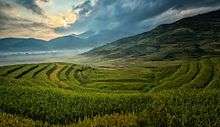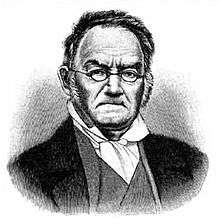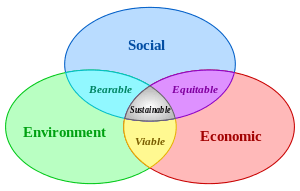Human geography
Human geography is the branch of social sciences that deals with the study of people and their communities, cultures, economies, and interactions with the environment by studying their relations with and across space and place.[1] Human geography attends to human patterns of social interaction, as well as spatial level interdependencies, and how they influence or affect the earth's environment.[2][3] As an intellectual discipline, geography is divided into the sub-fields of physical geography and human geography, the latter concentrating upon the study of human activities, by the application of qualitative and quantitative research methods.
History
| History of geography |
|---|
 |
Geography was not recognized as a formal academic discipline until the 18th century, although many scholars had undertaken geographical scholarship for much longer, particularly through cartography.
The Royal Geographical Society was founded in England in 1830,[4] although the United Kingdom did not get its first full Chair of geography until 1917. The first real geographical intellect to emerge in United Kingdom's geographical minds was Halford John Mackinder, appointed reader at Oxford University in 1887.
The National Geographic Society was founded in the United States in 1888 and began publication of the National Geographic magazine which became, and continues to be, a great popularizer of geographic information. The society has long supported geographic research and education on geographical topics.
The Association of American Geographers was founded in 1904 and was renamed the American Association of Geographers in 2016 to better reflect the increasingly international character of its membership.
One of the first examples of geographic methods being used for purposes other than to describe and theorize the physical properties of the earth is John Snow's map of the 1854 Broad Street cholera outbreak. Though a physician and a pioneer of epidemiology, the map is probably one of the earliest examples of health geography.
The now fairly distinct differences between the subfields of physical and human geography have developed at a later date. This connection between both physical and human properties of geography is most apparent in the theory of environmental determinism, made popular in the 19th century by Carl Ritter and others, and has close links to the field of evolutionary biology of the time. Environmental determinism is the theory, that people's physical, mental and moral habits are directly due to the influence of their natural environment. However, by the mid-19th century, environmental determinism was under attack for lacking methodological rigor associated with modern science, and later as a means to justify racism and imperialism.
A similar concern with both human and physical aspects is apparent during the later 19th and first half of the 20th centuries focused on regional geography.The goal of regional geography, through something known as regionalization, was to delineate space into regions and then understand and describe the unique characteristics of each region through both human and physical aspects. With links to possibilism and cultural ecology, some of the same notions of causal effect of the environment on society and culture remain with environmental determinism.
By the 1960s, however, the quantitative revolution led to strong criticism of regional geography. Due to a perceived lack of scientific rigor in an overly descriptive nature of the discipline, and a continued separation of geography from its two subfields of physical and human geography and from geology, geographers in the mid-20th century began to apply statistical and mathematical models in order to solve spatial problems.[1] Much of the development during the quantitative revolution is now apparent in the use of geographic information systems; the use of statistics, spatial modeling, and positivist approaches are still important to many branches of human geography. Well-known geographers from this period are Fred K. Schaefer, Waldo Tobler, William Garrison, Peter Haggett, Richard J. Chorley, William Bunge, and Torsten Hägerstrand.
From the 1970s, a number of critiques of the positivism now associated with geography emerged. Known under the term 'critical geography,' these critiques signaled another turning point in the discipline. Behavioral geography emerged for some time as a means to understand how people made perceived spaces and places, and made locational decisions. The more influential 'radical geography' emerged in the 1970s and 1980s. It draws heavily on Marxist's theory and techniques, and is associated with geographers such as David Harvey and Richard Peet. Radical geographers seek to say meaningful things about problems recognized through quantitative methods,[5] provide explanations rather than descriptions, put forward alternatives and solutions, and be politically engaged,[6] rather than using the detachment associated with positivists. (The detachment and objectivity of the quantitative revolution was itself critiqued by radical geographers as being a tool of capital). Radical geography and the links to Marxism and related theories remain an important part of contemporary human geography (See: Antipode (Journal)). Critical geography also saw the introduction of 'humanistic geography', associated with the work of Yi-Fu Tuan, which pushed for a much more qualitative approach in methodology.
The changes under critical geography have led to contemporary approaches in the discipline such as feminist geography, new cultural geography, and the engagement with postmodern and post-structural theories and philosophies.
Fields
The primary fields of study in human geography focus around the core fields of:
Culture
Cultural geography is the study of cultural products and norms - their variation across spaces and places, as well as their relations. It focuses on describing and analyzing the ways language, religion, economy, government, and other cultural phenomena vary or remain constant from one place to another and on explaining how humans function spatially.[7]

- Subfields include: Social geography, Animal geographies, Language geography, Sexuality and Space, Children's geographies, and Religion geography.
Development
Development geography is the study of the Earth's geography with reference to the standard of living and the quality of life of its human inhabitants, study of the location, distribution and spatial organization of economic activities, across the Earth. The subject matter investigated is strongly influenced by the researcher's methodological approach.
Economic
Economic geography examines relationships between human economic systems, states, and other factors, and the biophysical environment.
- Subfields include Marketing geography and Transportation geography
Health
Health geography is the application of geographical information, perspectives, and methods to the study of health, disease, and health care. Health geography deals with the spatial relations and patterns between people and the environment. This is a sub-discipline of human geography, researching how and why diseases are spread.[8]
Historical
Historical geography is the study of the human, physical, fictional, theoretical, and "real" geographies of the past. Historical geography studies a wide variety of issues and topics. A common theme is the study of the geographies of the past and how a place or region changes through time. Many historical geographers study geographical patterns through time, including how people have interacted with their environment, and created the cultural landscape.
- Subfields include Time geography
Political
Political geography is concerned with the study of both the spatially uneven outcomes of political processes and the ways in which political processes are themselves affected by spatial structures.
- Subfields include Electoral geography, Geopolitics, Strategic geography and Military geography
Population
Population geography is the study of ways in which spatial variations in the distribution, composition, migration, and growth of populations are related to their environment or location.
Settlement
Settlement geography, including urban geography, is the study of urban and rural areas with specific regards to spatial, relational and theoretical aspects of settlement. That is the study of areas which have a concentration of buildings and infrastructure. These are areas where the majority of economic activities are in the secondary sector and tertiary sectors. In case of urban settlement, they probably have a high population density.
Urban
Urban geography is the study of cities, towns, and other areas of relatively dense settlement. Two main interests are site (how a settlement is positioned relative to the physical environment) and situation (how a settlement is positioned relative to other settlements). Another area of interest is the internal organization of urban areas with regard to different demographic groups and the layout of infrastructure. This subdiscipline also draws on ideas from other branches of Human Geography to see their involvement in the processes and patterns evident in an urban area.[9] [10]
- Subfields include Economic geography, Population geography, and Settlement geography. These are clearly not the only subfields that could be used to assist in the study of Urban geography, but they are some major players.[9]
Philosophical and theoretical approaches
Within each of the subfields, various philosophical approaches can be used in research; therefore, an urban geographer could be a Feminist or Marxist geographer, etc.
Such approaches are:
- Animal geographies
- Behavioral geography
- Cognitive geography
- Critical geography
- Feminist geography
- Marxist geography
- Non-representational theory
- Positivism
- Postcolonialism
- Poststructuralist geography
- Psychoanalytic geography
- Psychogeography
- Spatial analysis
List of notable human geographers

- Alexander von Humboldt (1769-1859), one of the founders of modern geography, he traveled extensively and pioneered empirical research methods that would later develop primarily into biogeography and physical geography but also anticipated population geography and economic geography. Humboldt University of Berlin is named after Alexander and his brother Wilhelm von Humboldt.
- Carl Ritter (1779–1859), considered to be one of the founders of modern geography and first chair in geography at the Humboldt University of Berlin, also noted for his use of organic analogy in his works.
- Xavier Hommaire de Hell (1812–1848), research in Turkey, southern Russia and Persia
- Élisée Reclus (1830–1905), known for his monumental 19 volume The Earth and Its Inhabitants, he coined the term social geography and his thinking anticipated the social ecology and animal rights movements, where he advocated anarchism and veganism as part of an ethical life.
- Peter Kropotkin (1842–1921), one of the first radical geographers, he was a proponent of anarchism and notable for his introduction of the concept of mutual aid.
- Friedrich Ratzel (1844–1904), environmental determinist, invented the term Lebensraum
- Paul Vidal de la Blache (1845–1918), founder of the French School of geopolitics and possibilism.
- Sir Halford John Mackinder (1861–1947), author of The Geographical Pivot of History, co-founder of the London School of Economics, along with the Geographical Association.
- Jovan Cvijić (1865–1927), a Serbian geographer and a world-renowned scientist. He started his scientific career as a geographer and geologist, and continued his activity as an anthropogeographer and sociologist.
- Carl O. Sauer (1889–1975), critic of environmental determinism and proponent of cultural ecology.
- Walter Christaller (1893–1969), economic geographer and developer of the central place theory.
- Richard Hartshorne (1899–1992), scholar of the history and philosophy of geography.
- Torsten Hägerstrand (1916–2004), key figure in the quantitative revolution and regional science, developer of time geography and indirect contributor to aspects of critical geography.
- Milton Santos (1926–2001) winner of the Vautrin Lud Prize in 1994, one of the most important geographers in South America.
- Waldo R. Tobler (born 1930), developer of the First law of geography.
- Gamal Hamdan (born 1928), an Egyptian thinker, intellect and professor of geography. Best known for The Character of Egypt, Studies of the Arab World, and The Contemporary Islamic World Geography, which form a trilogy on Egypt's natural, economic, political and cultural character and its position in the world.
- Yi-Fu Tuan (born 1930) Professor Emeritus at University of Wisconsin–Madison, key figure behind the development of humanist and phenomenological geography and the most prominent Chinese-American geographer. Recipient of the Vautrin Lud Prize in 2012.
- David Harvey (born 1935), world's most cited academic geographer and winner of the Lauréat Prix International de Géographie Vautrin Lud, also noted for his work in critical geography and critique of global capitalism.
- Evelyn Stokes (1936–2005). Professor of geography at the University of Waikato in New Zealand. Known for recognizing inequality with marginalised groups including women and Māori using geography.
- Allen J. Scott (born 1938), winner of Vautrin Lud Prize in 2003 and the Anders Retzius Gold medal 2009; author of numerous books and papers on economic and urban geography, known for his work on regional development, new industrial spaces, agglomeration theory, global city-regions and the cultural economy.
- Edward Soja (1941-2015), noted for his work on regional development, planning and governance, along with coining the terms synekism and postmetropolis.
- Doreen Massey (1944-2016), key scholar in the space and places of globalization and its pluralities, winner of the Vautrin Lud Prize.
- Michael Watts, Class of 1963 Professor of Geography and Development Studies, University of California, Berkeley
- Nigel Thrift (born 1949), developer of non-representational theory.
- Derek Gregory (born 1951), famous for writing on the Israeli, U.S. and UK actions in the Middle East after 9/11, influenced by Edward Said and has contributed work on imagined geographies.
- Cindi Katz (born 1954), who writes on social reproduction and the production of space. Writing on children's geographies, place and nature, everyday life and security.
- Gillian Rose (born 1962), most famous for her critique: Feminism & Geography: The Limits of Geographical Knowledge (1993), which was one of the first moves towards a development of feminist geography.
Journals
As with all social sciences, human geographers publish research and other written work in a variety of academic journals. Whilst human geography is interdisciplinary, there are a number of journals that focus on human geography.
These include:
- ACME: An International E-Journal for Critical Geographies[11]
- Antipode
- Area
- Economic geography
- Environment and Planning
- Geografiska Annaler
- GeoHumanities[12]
- Global Environmental Change: Human and Policy Dimensions[13]
- Migration Letters
- Social & Cultural Geography[14]
- Transactions of the Institute of British Geographers
- Geoforum
- Progress in Human Geography
- Tijdschrift voor economische en sociale geografie
See also
References
- 1 2 Johnston, Ron (2000). "Human Geography". In Johnston, Ron; Gregory, Derek; Pratt, Geraldine; et al. The Dictionary of Human Geography. Oxford: Blackwell. pp. 353–60.
- ↑ Russel, Polly. "Human Geography". British Library. Retrieved 26 February 2017.
- ↑ Reinhold, Dennie (February 7, 2017). "Human Geography". www.geog.uni-heidelberg.de. Retrieved 2017-02-23.
- ↑ Royal Geographical Society. "History". Retrieved 9 March 2011.
- ↑ Harvey, David (1973). Social Justice and the City. London: Edward Arnold. pp. 128–9.
- ↑ Antipode: A Radical Journal of Geography (2009). "Antipode: A Radical Journal of Geography: Celebrating Over 40 years of Radical Geography 1969-2009". Retrieved 31 May 2010.
- ↑ Jordan-Bychkov, Terry G.; Domosh, Mona; Rowntree, Lester (1994). The human mosaic: a thematic introduction to cultural geography. New York: HarperCollinsCollegePublishers. ISBN 978-0-06-500731-2.
- ↑ Dummer, Trevor J.B. (2008-04-22). "Health geography: supporting public health policy and planning". CMAJ : Canadian Medical Association Journal. 178 (9): 1177–1180. ISSN 0820-3946. PMC 2292766
 . PMID 18427094. doi:10.1503/cmaj.071783.
. PMID 18427094. doi:10.1503/cmaj.071783. - 1 2 Palm, Risa (2016-09-05). "Urban geography: city structures". Progress in Geography. doi:10.1177/030913258200600104.
- ↑ Kaplan, Dave H.; Holloway, Steven; Wheeler, James O. (2014). Urban Geography, 3rd. Edition. Hoboken, NJ: Wiley. ISBN 978-1-118-57385-3.
- ↑ ACME journal homepage. Accessed: May 18, 2015.
- ↑ Accessed: July 26, 2017.
- ↑ Global Environmental Change homepage
- ↑ Accessed: July 26, 2017.
Further reading
- Blij, Harm Jan, De (2008). Geography: realms, regions, and concepts. Hoboken, NJ: John Wiley. ISBN 978-0-470-12905-0.
- Clifford, N.J.; Holloway, S.L.; Rice, S.P.; Valentine, G., eds. (2009). Key Concepts in Geography (2nd ed.). London: SAGE. ISBN 978-1-4129-3021-5.
- Cloke, Paul J.; Crang, Philip; Goodwin, Mark (2004). Envisioning human geographies. London: Arnold. ISBN 978-0-340-72013-4.
- Cloke, Paul J.; Crang, Phil; Crang, Philip; Goodwin, Mark (2005). Introducing human geographies (2nd ed.). London: Hodder Arnold. ISBN 978-0-340-88276-4.
- Crang, Mike; Thrift, Nigel J. (2000). Thinking space. London: Routledge. ISBN 978-0-415-16016-2.
- Daniels, Peter; Bradshaw, Michael; Shaw, Denis J. B.; Sidaway, James D. (2004). An Introduction to Human Geography: issues for the 21st century (2nd ed.). Prentice Hall. ISBN 978-0-13-121766-9.
- Flowerdew, Robin; Martin, David (2005). Methods in human geography: a guide for students doing a research project (2nd ed.). Harlow: Prentice Hall. ISBN 978-0-582-47321-8.
- Gregory, Derek; Martin, Ron G.; Smith, Graham (1994). Human geography: society, space and social science. Basingstoke: Macmillan. ISBN 978-0-333-45251-6.
- Harvey, David D. (1996). Justice, Nature and the Geography of Difference. Blackwell Pub. ISBN 978-1-55786-680-6.
- Johnston, R.J. (2009). The Dictionary of Human Geography (5th ed.). Blackwell Publishers, London.
- Johnston, R.J (2002). Geographies of Global Change: Remapping the World. Blackwell Publishers, London.
- Moseley, William W.; Lanegran, David A.; Pandit, Kavita (2007). The Introductory Reader in Human Geography: Contemporary Debates and Classic Writings. Malden, MA: Blackwell Publishing Limited. ISBN 978-1-4051-4922-8.
- Peet, Richard, ed. (1998). Modern Geographical Thought. Oxford: Wiley-Blackwell. ISBN 978-1-55786-378-2.
- Soja, Edward (1989). Postmodern Geographies: The Reassertion of Space in Critical Social Theory. Verso, London.
External links
- Worldmapper - Mapping project using social data sets
Notes
·Urbanization is a major proponent to human and population geography, especially over the past 100 years as population shift has moved to urban areas. [1]
- ↑ In only 200 years, the world's urban population has grown from 2 percent to nearly 50 percent of all people.


